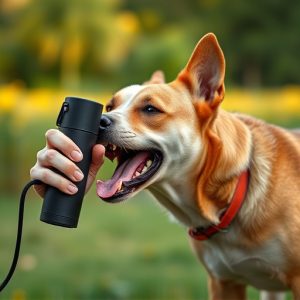Mastering Dog Deterrent Spray: Active Ingredients for Effective Training
Dogs' keen senses drive chasing and barking behaviors, making effective dog deterrent sprays cr…….
Dogs' keen senses drive chasing and barking behaviors, making effective dog deterrent sprays crucial. Key active ingredients like capsaicin or essential oils (citronella, lavender, peppermint) disrupt these sensory triggers without harm. These natural formulas train dogs to associate specific scents with unpleasant experiences, reducing unwanted behaviors. For optimal application, use protective gear, spray at a distance on calm days, and repeat every 7-14 days. Combine spray use with positive reinforcement training for long-term behavior modification, tailored to indoor or outdoor environments.
“Unsure how to handle your dog’s persistent barking and chasing? Discover the best formula for a dog deterrent spray that addresses these behaviors naturally and safely. This comprehensive guide explores active ingredients proven to deter dogs, offering a step-by-step application process. We also delve into training techniques for long-lasting results and environmental considerations when choosing the right spray for your specific needs. Understanding dog behavior and the right active ingredients in dog repellent spray is key to achieving a peaceful environment.”
- Understanding Dog Behavior: Why They Chase and Bark
- Safe and Effective Active Ingredients for Dog Deterrent Spray
- How to Apply Dog Repellent Spray: Step-by-Step Guide
- Training Your Dog: Complementary Techniques for Long-Term Deterrence
- Environmental Considerations: Choosing the Right Spray for Different Settings
Understanding Dog Behavior: Why They Chase and Bark
Dogs chase and bark for various reasons, from natural instincts to environmental triggers. Understanding their behavior is key when choosing an effective dog deterrent spray. One of the primary motivations is their strong scent detection, which they use to explore and communicate. Dogs have over 200 million scent receptors compared to our mere 5 million, making them highly attuned to smells. This heightened sense often leads to chasing small animals or people, as it triggers a hunting instinct. Additionally, barking can be a response to unfamiliar sights, sounds, or scents, serving as a warning or a way to protect their territory.
The formula of a dog repellent spray should target these behaviors by incorporating active ingredients that disrupt the dog’s sensory experience without causing harm. Common effective substances include capsaicin, found in chili peppers, which can deter dogs through its burning sensation, and certain essential oils like citronella or peppermint oil known for their strong aromas. These natural components can help train dogs to associate specific scents with an unpleasant experience, thereby reducing unwanted behaviors.
Safe and Effective Active Ingredients for Dog Deterrent Spray
When crafting a dog deterrent spray, understanding the role of active ingredients is paramount. These are the key components that make the spray effective in repelling canine intruders. Opt for formulas containing natural and safe elements like capsaicin, which is derived from chili peppers. This ingredient stimulates a mild sensation in dogs, deterring them without causing any significant harm or long-term effects.
Additionally, essential oils such as citronella, lavender, and peppermint are powerful natural deterrents. They offer a pleasant aroma for humans while creating an unpleasant experience for dogs. These active ingredients are not only effective but also environmentally friendly and safe for use around children and other pets when used according to instructions.
How to Apply Dog Repellent Spray: Step-by-Step Guide
To effectively apply a dog repellent spray, start by ensuring your safety and the environment’s cleanliness. Put on protective gloves and choose a calm, wind-still day to avoid the spray from blowing back onto you or nearby plants. Begin by shaking the can vigorously for about 2-3 seconds to mix the active ingredients in Dog Repellent Spray. Hold the can upright, 15-20 cm away from the target area, and spray a light, even coat. Focus on treating areas where dogs tend to congregate or enter, such as doorways, windowsills, and fences.
Repeat the application every 7-14 days, or as needed, based on the product’s effectiveness and local weather conditions. Remember, consistency is key; regular applications reinforce the scent barrier, making your space less appealing to dogs over time.
Training Your Dog: Complementary Techniques for Long-Term Deterrence
Training your dog is a crucial complement to using a dog deterrent spray, ensuring long-term deterrence and behavior modification. Incorporating positive reinforcement techniques during training can be highly effective. Reward your dog with treats and praise when it exhibits desired behaviors in the presence of triggers that would typically cause barking or aggression. This association reinforces good behavior and strengthens the bond between you and your pet.
When selecting an effective dog repellent spray, consider the active ingredients for their safety and potency. Active ingredients like capsaicin, citronella, or certain essential oils can be highly effective in deterring dogs without causing them harm. Combining these with a solid training regimen allows for a multi-faceted approach to addressing unwanted behaviors, leading to lasting results.
Environmental Considerations: Choosing the Right Spray for Different Settings
When selecting a dog deterrent spray, environmental considerations are paramount. Different settings require tailored solutions. For instance, a spray designed for indoor use should be safe and non-toxic to pets and humans, with minimal odor and no harmful residues. Active ingredients like capsaicin (from chili peppers) or citronella oil can be effective indoors as they disrupt dogs’ sense of smell without leaving a persistent scent that could offend human occupants.
In outdoor environments, factors like weather resistance and longevity become crucial. Water-resistant formulas ensure the spray stays effective during rain or playtime in the garden. Additionally, considering the locale—be it urban, suburban, or rural—is essential. Urban areas might require sprays with a stronger scent to penetrate through pollution and other scents, while rural settings may call for more natural ingredients that are gentle on the environment.
When it comes to choosing the best dog deterrent spray, understanding both canine behavior and the formula’s active ingredients is key. By addressing your dog’s underlying motivations and selecting a product with safe, effective components tailored to your environment, you can achieve long-lasting results. Remember, while these sprays are powerful tools, they should complement positive training techniques for holistic, successful deterrence.


